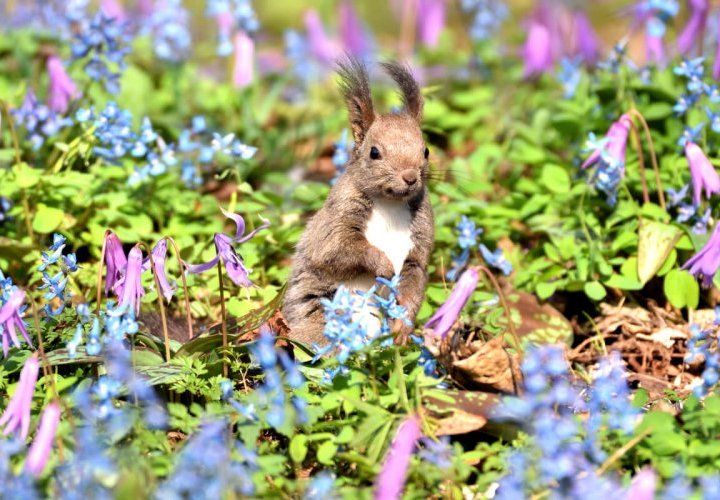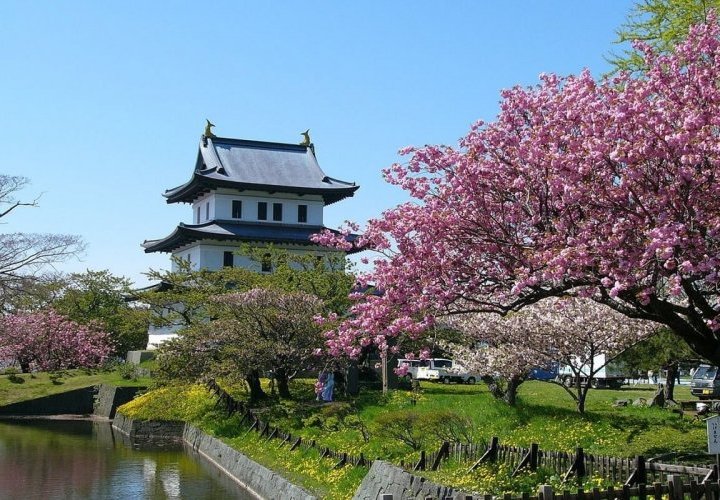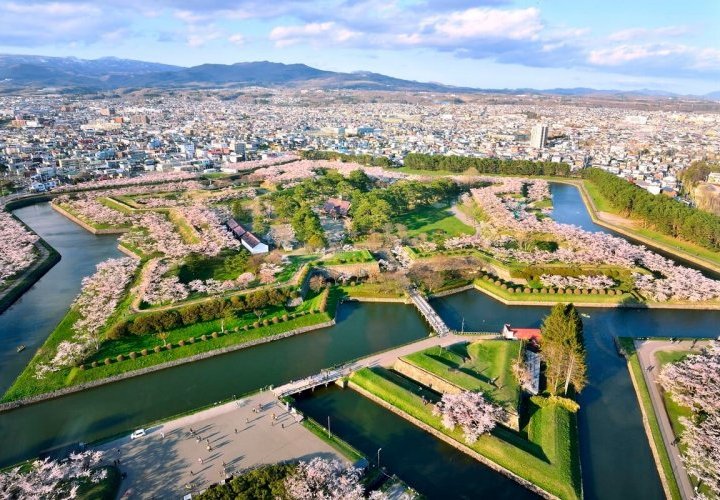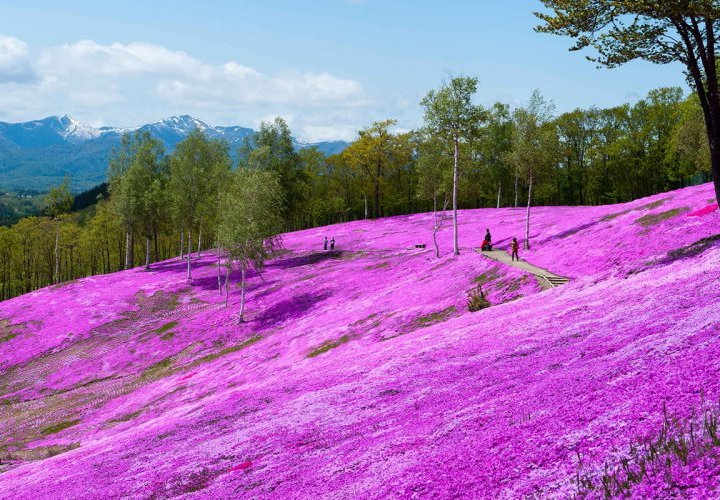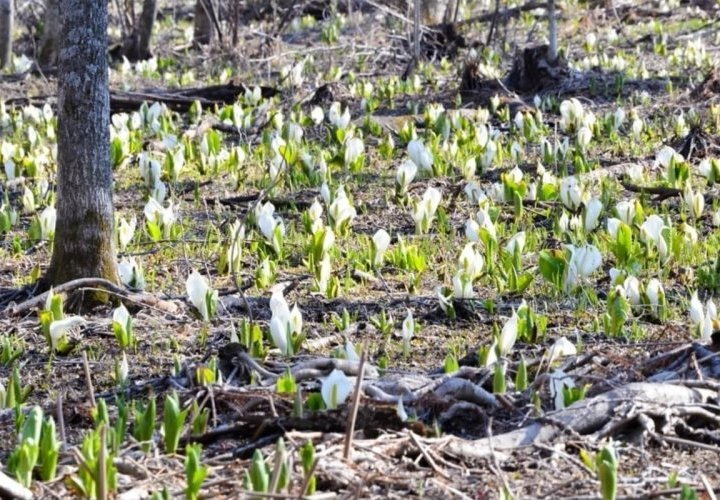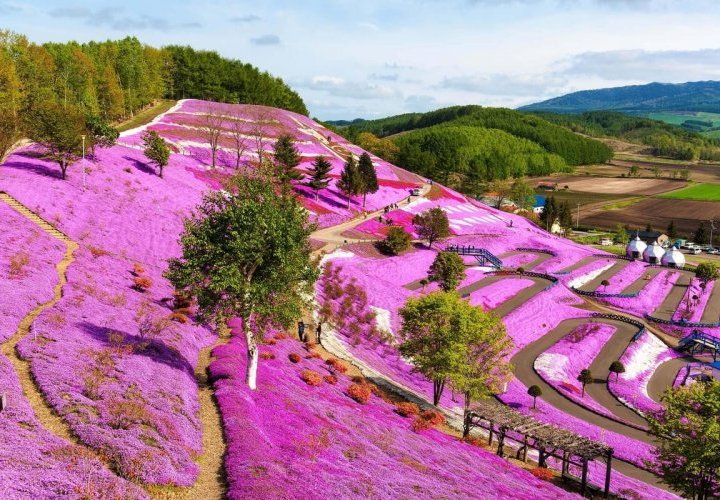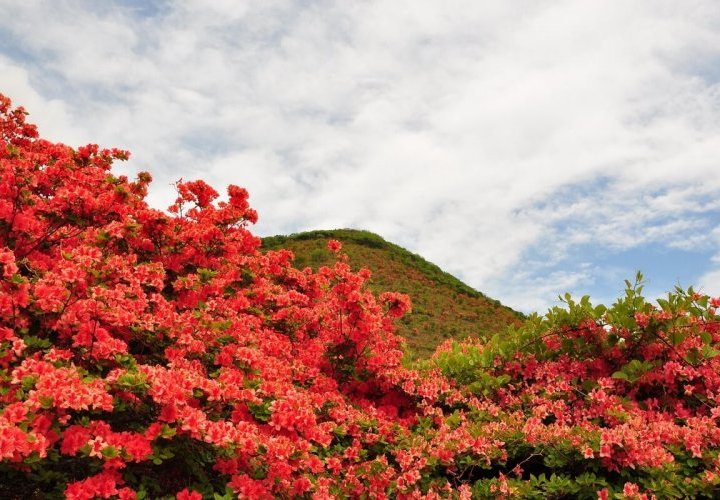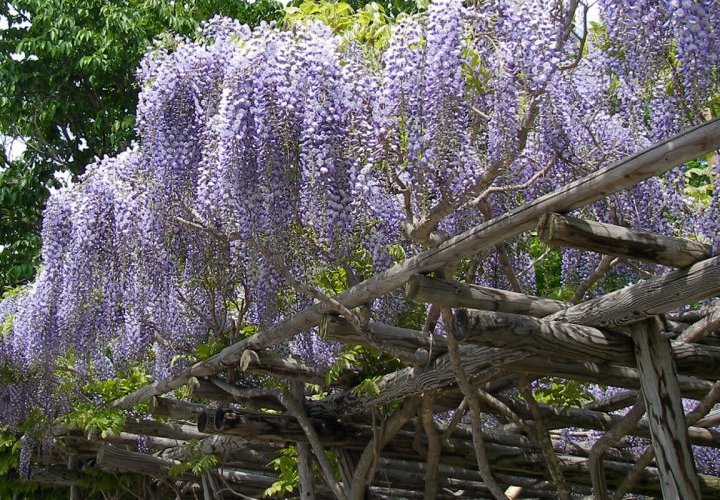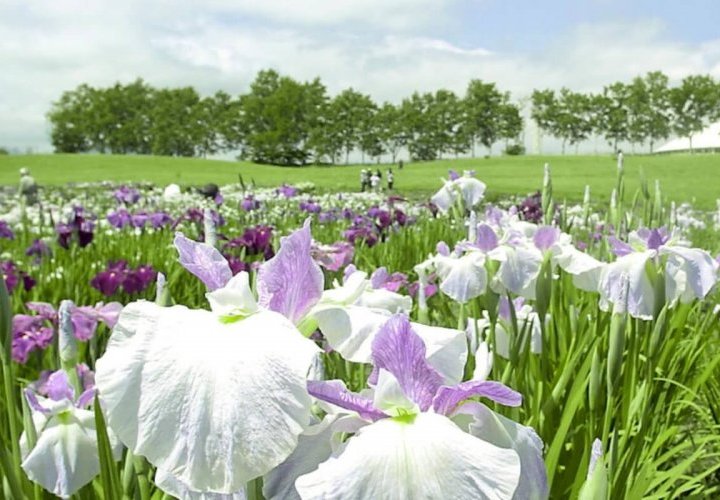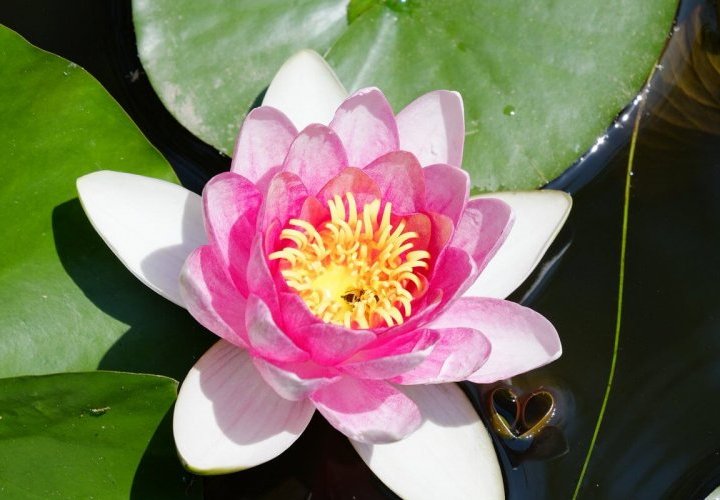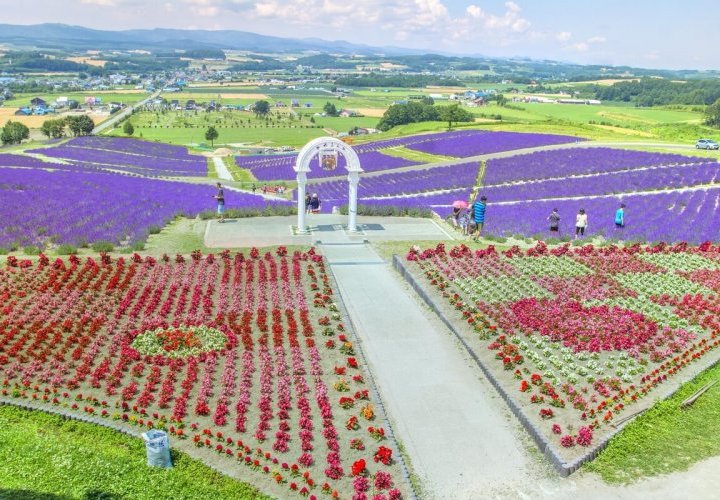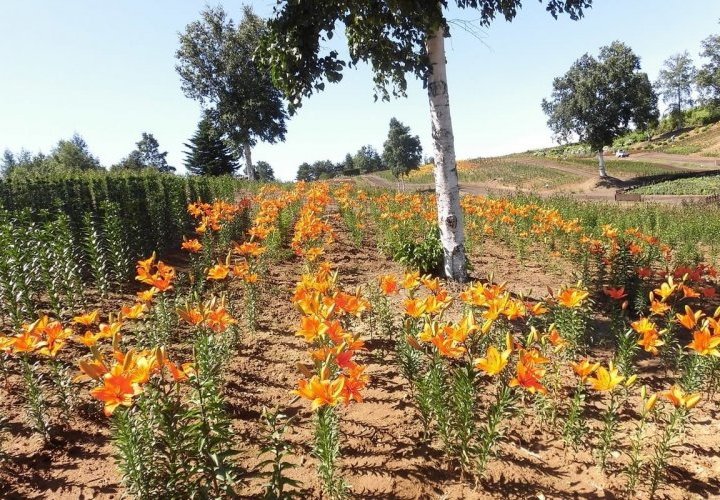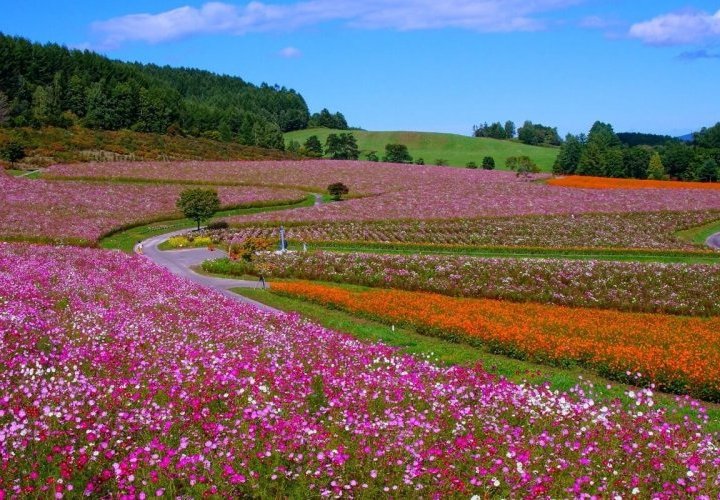Hokkaido is famous in Japan for having many spectacular flower fields, which are top tourist attractions from spring to autumn, when colourful flowers are in blossom. Different kinds of flowers cover the vast fields of the island vividly, forming never-ending carpets, which create a scenery that is unique in the vast Hokkaido.
This is a historic park with 300-year-old trees famous as a cherry blossom park. Every year from late April to early May, 1,000 cherry trees blossom here all at once. There are 17 varieties of cherry trees including “Someiyoshino”, “Hyakusai Sakura” (100-year-old cherry tree), “Morikomachi” and “Aoba Shidare”. The last two are said to be the only ones that exist on Earth and can only be found here. more
Cherry blossoms in Matsumae Park, Matsumae (late April to late May)
Matsumae Park is well known for its cherry blossoms from late April to late May. The Park has been selected for inclusion in the list of Japan’s Top 100 Cherry Blossom Spots and about 250 cherry species grow here on about 10,000 trees. Its nickname is the “Little Kyoto of the North” because of its resemblance to Teramachi in Kyoto. Early bloom, mid-bloom and late bloom can all be enjoyed during one-month period. You should definitely see the “Three Famous Cherry Trees of Matsumae” which are “Kechimyaku-zakura”, “Meoto-zakura” and “Ezokasumi-zakura”.
Dogtooth violet and corydalis ambigua at Urausu Shrine, Urausu (late April to early May)
In Spring, you can see a flower carpet of dogtooth violet (from late April to early May) and corydalis ambigua (from late April to mid-May) colouring the promenade at Urausu Shrine. You will enjoy a fantastic scenery of blue and violet flowers and you will be mesmerized by their scent. If you are lucky, you will even see a Hokkaido squirrel!
Dahurian azalea in Kitami Tsutsuji Park, Kitami (late April to early May)
The park is famous for its 3,000 azaleas that blossom from late April to early May every year making an impressively beautiful pink scenery.
Dogtooth violet and corydalis ambigua in Sakuragaoka Park, Niseko (late April to late May)
Sakuragaoka Park is a great place to see colonies of Ezoengosaku (corydalis ambigua) and Katakuri (Dogtooth violet), and also a great location for bird watching.
Cherry blossoms in Goryokaku Park, Hakodate (early May)
Goryokaku Park is also a very popular place in Hokkaido to see cherry blossoms in early May. Over 1,600 cherry blossom trees, mainly Yoshino cherry trees, have been planted here. Many trees were planted when the park was opened to the public in 1914. During the cherry blossom season, lanterns will light your way to admire this beautiful atmosphere at night and you can have a picnic and enjoy traditional Hokkaido barbecue under the blooms.
Cherry blossoms along Nijukken-doro, Shinhidaka (early to mid-May)
Nijukken-doro is a 36-m-wide avenue and one of the most well-known places for cherry blossom viewing in early to mid-May. The 7 km straight road is lined with about 3,000 cherry trees, 70% of which are Sargent’s cherries or North Japanese Hill Cherries.
Plum (ume) blossoms in Hiraoka Park, Sapporo (early to mid-May)
There are around 1,200 plum trees in Hiraoka Park that blossom from early to mid-May. The red and white flowers of different plum trees contrast beautifully and allow visitors to enjoy a beautiful scenery. A little earlier than the cherry blossoms, when in full bloom, they announce the arrival of spring in this northern part of the country.
Daffodil in Tamagawa Park, Setana (early to mid-May)
Every year, from early to mid-May about 300,000 daffodils of 30 kinds bloom in the park spreading out on the small hill around Tamagawa Shrine.
Moss phlox in Takinoue Park, Takinoue (early May to early June)
The whole park is covered with a bright pink carpet of moss phlox flowers from early May to early June. In 1956 the park was planted with moss phlox seeds that fitted in a “mandarin orange box”. More and more flowers were planted each year until they reached an area of 100,000 m2. The beautiful carpet of flowers covers the hillsides for about a month. Apart from their beautiful bright pink colour, they fill the park with a sweet scent, drawing you into a dreamlike world.
Tulip in Kamiyubetsu Tulip Park, Kamiyubetsu (early May to early June)
Kamiyubetsu Tulip Park is a spring wonderland filled with tons of different kinds of tulips that blossom from early May to early June. There are about 1,200,000 colourful tulips of 120 varieties growing in rows and making a quite nice looking rainbow tulip field.
Tulip in Shichiku Garden, Obihiro (early May to early June)
Shichiku Garden is a place where visitors can see colourful pallets of flowerbeds that boast of 40,000 tulips of around 300 varieties. You can also enjoy different flowers to the fullest every season at the flower gardens where about 2,500 types of flowers blossom on 12 areas.
Plum (ume) blossoms in Sobetsu Park, Sobetsu (mid-May)
Sobetsu Park is one of the must-see spots in Sobetsu, especially in spring (mid-May), when the 300 plum trees that grow around the park are in blossom.
Cherry blossoms at Seiryuji Temple, Nemuro (mid to late May)
Seiryuji Temple that opened in 1892 is a popular place for admiring chishima cherry trees blossoms in mid to late May. These kind of cherries are found in eastern and northern Hokkaido and their particularity is that the flowers change the colour during the blooming: light red when they begin to bloom, white when they are in full bloom, and red at the end of blooming.
Skunk cabbage near Lake Abashiri, Abashiri (mid to late May)
From mid to late May, near Lake Abashiri you can see Japan’s largest patch of skunk cabbage flowers on an area of 52 hectares. Their name is far from appealing, but these white flowers look similar to carla lily. The place is not far from the highway, so you do not have to go far to enjoy the beauty of these white flowers.
Moss phlox in Higashimokoto Shibazakura Park, Ozora (mid-May to early June)
Shibazakura (moss phlox) is a popular spring flower in Japan. It can be admired from mid-May to early June at Higashimokoto Shibazakura Park which is a vast park (10 ha) located at the foot of Mt. Mokoto. Its vivid pink flowers cover the entire park. On top of the hill, there is an observatory from where the panoramic view of the park can be enjoyed.
Lilac in Odori Park and Kawashimo Park, Sapporo (mid-May to early June)
Lilac is the official tree of Sapporo designated as such in 1960. Odori Park has beautiful walking paths through which you can walk along and view lilacs from mid-May to early June. Around 400 lilac trees were planted in Odori Park that boost aromatic flowers of white, purple and pink colours. At Kawashimo Park, there are about 1,700 lilac trees of 200 different kinds. It is very relaxing when you take a stroll around it and view such a large number of lilacs in a single place.
Azalea in Tsutsuji Park, Hakodate (late May to early June)
About 600,000 azaleas blossom in Tsutsuji Park from late May to early June, turning the foot of Mount Esan into a riot of rose pink blossoms. It takes about 40 minutes to get to the park from Hakodate Airport.
Lily in Yurigahara Park, Sapporo (early June to late September)
At Yurigahara Park the trains run among flowers. Many species of lilies are grown on an area of about 5 hectares. Their flowers can be seen from early June to late September, but the best time to see them is in mid-July. It is in mid-July when about 15,000 regal lilies make a beautiful scenery of white flowers.
Japanese wisteria at Koseiji Temple and Heiwayama Park, Engaru (mid-June)
Beautiful wisteria blooms can be seen at Koseiji Temple and Heiwayama Park in the middle of June every year. One of the first things you will notice is obviously the wisteria flowers, and the wooden tall clock of Heiwayama Koen.
Blue poppy at Reindeer Farm, more
At Yurigahara Park the trains run among flowers. Many species of lilies are grown on an area of about 5 hectares. Their flowers can be seen from early June to late September, but the best time to see them is in mid-July. It is in mid-July when about 15,000 regal lilies make a beautiful scenery of white flowers.
Japanese wisteria at Koseiji Temple and Heiwayama Park, Engaru (mid-June)
Beautiful wisteria blooms can be seen at Koseiji Temple and Heiwayama Park in the middle of June every year. One of the first things you will notice is obviously the wisteria flowers, and the wooden tall clock of Heiwayama Koen.
Blue poppy at Reindeer Farm, more
Horonobe (mid-June to mid-July)
In the North Garden within the Reindeer Farm, you can see the beautiful blue poppies fluttering in the wind for about a month between mid-June to mid-July. Apart from reindeers, which are gentle animals, the blue colour of the poppies also attracts visitors who are anxious to see them.
Cleome in the flower gardens of Shikisai-no-oka, Biei (mid-June to mid-September)
The impressive flower gardens of Shikisai-no-oka stretching over an area of fifteen hectares in Biei provide fantastic views of seasonal blossoms, and you can enjoy various flowers from spring to fall. From mid-June to mid-September the beautiful cleome flowers are in blossom here.
Iris at Hakko Gakuen, Sapporo (early to late July)
Hakko Gakuen is a vocational training school of agriculture and has been opened since 1931. The beautiful Japanese Iris Garden is famous for its 100,000 irises of 450 kinds and is open to the public only from early July to late July for about 2 weeks.
Rose in Chippubetsu Rose Garden, Chippubetsu (early to late July)
There are 3,000 roses of 300 different kinds in bloom in the garden that blossom from early to late July. At the Bara no Shiro Flora rest spot, you can find an observatory and a kiosk where you can buy Akazukinchan (literally “red-lover”) tomato juice, dried flowers, rose wine and more. The rose ice cream is also popular.
Water lily in Hachironuma Park, Hokuto (early July to mid-August)
Water lilies spread beautifully in Hachironuma Park over the surface of the lake from early-July to mid-August.
Sunflower in Himawari no Sato, Hokuryu (early July to mid-August)
All the tourists who visit Hokkaido in summer should certainly admire the sunflower field in a little town called Hokuryu where around 1,500,000 sunflowers bloom from early July to mid-August. Himawari no Sato is seen as the beautiful and splendid sunflower garden in Japan. It is only 119 km away from Sapporo station taking less than 1 hour and 50 minutes by train.
Iris in Ayame Park, Iwamizawa (mid-July)
Every year in mid-July the visitors of the park can admire the irises, predominantly consisting of Iris sanguinea (ayame) and Iris ensata (hanashobu). In total, there are 12,000 flowers of 168 different kinds.
Lavender in Hinode Park, Kamifurano (mid to late July)
Hinode Park in Kamifurano town opened in 1977. It is popular for its lavenders planted on the hillside of Mount Hinode with an altitude of about 230 m on an area of about 4.2 ha. The flowering season is from mid to late July. The bell of love was built on the hillside, and the park becomes the “Lovers’ Sanctuary” in summer.
Rose in Haboro Rose Garden, Haboro (mid-July to mid-August)
Every year from mid-July to mid-August you can see 2,000 roses of 334 different kinds and colours in full bloom. There is a kiosk during the rose season where rose ice cream, made with real roses is sold.
Buckwheat in the Buckwheat field, Horokanai (mid-July to mid-August)
The Buckwheat field in Horokanai is Japan’s largest buckwheat field having an area of 3,200 ha. From mid-July to mid-August the buckwheat field is covered with small white flowers forming a large beautiful carpet. The field has 4 famous viewing spots where white buckwheat flowers can be enjoyed: Soba-no-Hana Observation Deck, Hakugin-no-Oka (Silver) Hills, Junpaku-no-Oka (Snow-white) Hills and Shirojutan-no-Hatake.
Lily in Yuri-no-sato Koshimizu Lily Park, Koshimizu (mid-July to mid-September)
From mid-July to mid-September about 110 types of 7 million lilies planted on 2 hills on an area of around 13 ha can be admired in Yuri-no-Sato Koshimizu Lily Park. The best time to see the lilies is from early August to mid-August.
Sunflower in Chiebun, Nayoro (late July to mid-August)
The sunflower fields in Chiebun region were planted in 1897 and today there are around 6 million sunflowers on an area of about 50 ha in the whole Nayoro. They are in full bloom from late July to mid-August and you can admire a wonderful carpet of yellow flowers.
Cosmos in Taiyo-no-Oka Engaru Park, Engaru (mid-August to late September)
One of the largest cosmos gardens in Japan with cosmos flowers in bloom from mid-August to late September can be found in Taiyo-no-Oka Engaru Park. There are around 10 million cosmos flowers of different colours (pink, white, orange and yellow) blooming in a field larger than 100 thousand square metres. The Cosmos Garden is a popular tourist attraction in Eastern Hokkaido and many tourists visit it.
Cosmos at Maruka Highlands, Takikawa (mid to late September)
Ms. Cho Kuroyanagi, a popular essayist, nicknamed “Chotchan” came up with the proposal to make Takikawa a town of cosmos. Now the flower fields cover a vast area of 3 ha, becoming a picturesque sight in autumn.
Glasswort on the shores of Lake Notoro, Abashiri (mid to late September)
Glasswort colours the shores of Lake Notoro (a brackish lake separated by a sandbar from the Sea of Okhotsk) in red from mid to late September. These plants can be admired at a close distance from the boardwalk built near a plant colony in the Ubaranai area.
Hanakku flower clock in Tokachiga-oka Park, Tokachigawa
Tokachiga-oka Park is located near Togachigawa Spa, known for its water rich in minerals absorbed from vegetation. Green grass surrounds Hanakku and the flowers are planted in the shape of a clock. It is 18 m in diameter being decorated with 20,000 flowers. The flowers are planted five times from spring to autumn in order to maintain their vivid colours. During the summer, an event called "Flower scenes/Hanakku and flower road" is held. During the event, in addition to the flower clock, the Tokachigawa Onsen village gets decorated with vivid colours of driftwood flower planters, lattice, monuments, and more.
In the North Garden within the Reindeer Farm, you can see the beautiful blue poppies fluttering in the wind for about a month between mid-June to mid-July. Apart from reindeers, which are gentle animals, the blue colour of the poppies also attracts visitors who are anxious to see them.
Cleome in the flower gardens of Shikisai-no-oka, Biei (mid-June to mid-September)
The impressive flower gardens of Shikisai-no-oka stretching over an area of fifteen hectares in Biei provide fantastic views of seasonal blossoms, and you can enjoy various flowers from spring to fall. From mid-June to mid-September the beautiful cleome flowers are in blossom here.
Iris at Hakko Gakuen, Sapporo (early to late July)
Hakko Gakuen is a vocational training school of agriculture and has been opened since 1931. The beautiful Japanese Iris Garden is famous for its 100,000 irises of 450 kinds and is open to the public only from early July to late July for about 2 weeks.
Rose in Chippubetsu Rose Garden, Chippubetsu (early to late July)
There are 3,000 roses of 300 different kinds in bloom in the garden that blossom from early to late July. At the Bara no Shiro Flora rest spot, you can find an observatory and a kiosk where you can buy Akazukinchan (literally “red-lover”) tomato juice, dried flowers, rose wine and more. The rose ice cream is also popular.
Water lily in Hachironuma Park, Hokuto (early July to mid-August)
Water lilies spread beautifully in Hachironuma Park over the surface of the lake from early-July to mid-August.
Sunflower in Himawari no Sato, Hokuryu (early July to mid-August)
All the tourists who visit Hokkaido in summer should certainly admire the sunflower field in a little town called Hokuryu where around 1,500,000 sunflowers bloom from early July to mid-August. Himawari no Sato is seen as the beautiful and splendid sunflower garden in Japan. It is only 119 km away from Sapporo station taking less than 1 hour and 50 minutes by train.
Iris in Ayame Park, Iwamizawa (mid-July)
Every year in mid-July the visitors of the park can admire the irises, predominantly consisting of Iris sanguinea (ayame) and Iris ensata (hanashobu). In total, there are 12,000 flowers of 168 different kinds.
Lavender in Hinode Park, Kamifurano (mid to late July)
Hinode Park in Kamifurano town opened in 1977. It is popular for its lavenders planted on the hillside of Mount Hinode with an altitude of about 230 m on an area of about 4.2 ha. The flowering season is from mid to late July. The bell of love was built on the hillside, and the park becomes the “Lovers’ Sanctuary” in summer.
Rose in Haboro Rose Garden, Haboro (mid-July to mid-August)
Every year from mid-July to mid-August you can see 2,000 roses of 334 different kinds and colours in full bloom. There is a kiosk during the rose season where rose ice cream, made with real roses is sold.
Buckwheat in the Buckwheat field, Horokanai (mid-July to mid-August)
The Buckwheat field in Horokanai is Japan’s largest buckwheat field having an area of 3,200 ha. From mid-July to mid-August the buckwheat field is covered with small white flowers forming a large beautiful carpet. The field has 4 famous viewing spots where white buckwheat flowers can be enjoyed: Soba-no-Hana Observation Deck, Hakugin-no-Oka (Silver) Hills, Junpaku-no-Oka (Snow-white) Hills and Shirojutan-no-Hatake.
Lily in Yuri-no-sato Koshimizu Lily Park, Koshimizu (mid-July to mid-September)
From mid-July to mid-September about 110 types of 7 million lilies planted on 2 hills on an area of around 13 ha can be admired in Yuri-no-Sato Koshimizu Lily Park. The best time to see the lilies is from early August to mid-August.
Sunflower in Chiebun, Nayoro (late July to mid-August)
The sunflower fields in Chiebun region were planted in 1897 and today there are around 6 million sunflowers on an area of about 50 ha in the whole Nayoro. They are in full bloom from late July to mid-August and you can admire a wonderful carpet of yellow flowers.
Cosmos in Taiyo-no-Oka Engaru Park, Engaru (mid-August to late September)
One of the largest cosmos gardens in Japan with cosmos flowers in bloom from mid-August to late September can be found in Taiyo-no-Oka Engaru Park. There are around 10 million cosmos flowers of different colours (pink, white, orange and yellow) blooming in a field larger than 100 thousand square metres. The Cosmos Garden is a popular tourist attraction in Eastern Hokkaido and many tourists visit it.
Cosmos at Maruka Highlands, Takikawa (mid to late September)
Ms. Cho Kuroyanagi, a popular essayist, nicknamed “Chotchan” came up with the proposal to make Takikawa a town of cosmos. Now the flower fields cover a vast area of 3 ha, becoming a picturesque sight in autumn.
Glasswort on the shores of Lake Notoro, Abashiri (mid to late September)
Glasswort colours the shores of Lake Notoro (a brackish lake separated by a sandbar from the Sea of Okhotsk) in red from mid to late September. These plants can be admired at a close distance from the boardwalk built near a plant colony in the Ubaranai area.
Hanakku flower clock in Tokachiga-oka Park, Tokachigawa
Tokachiga-oka Park is located near Togachigawa Spa, known for its water rich in minerals absorbed from vegetation. Green grass surrounds Hanakku and the flowers are planted in the shape of a clock. It is 18 m in diameter being decorated with 20,000 flowers. The flowers are planted five times from spring to autumn in order to maintain their vivid colours. During the summer, an event called "Flower scenes/Hanakku and flower road" is held. During the event, in addition to the flower clock, the Tokachigawa Onsen village gets decorated with vivid colours of driftwood flower planters, lattice, monuments, and more.

